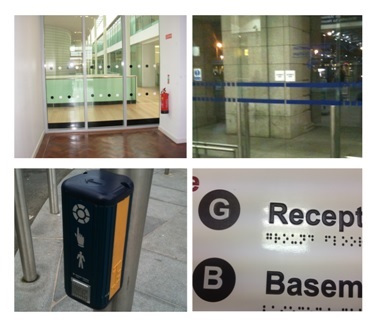Architects and designers - How are you considering Universal Design?
 In a recent article we highlighted the importance of thinking beyond disability access when designing buildings. Examples included the provision of parking for parents with small children; Baby changing facilities; mixed seating; changing places; signage and wayfinding and the design of facilities for people of different religious beliefs/culture.
In a recent article we highlighted the importance of thinking beyond disability access when designing buildings. Examples included the provision of parking for parents with small children; Baby changing facilities; mixed seating; changing places; signage and wayfinding and the design of facilities for people of different religious beliefs/culture.
However it still seems that many architects and designers are designing buildings with only disability access in mind. It is important to note that there has been a shift away from disability access design towards designing for all people regardless of age, size or disability. One of the key drivers in this shift is the principle of Universal Design.
Universal Design “is the design and composition of an environment so that it can be accessed, understood and used to the greatest extent possible by all people regardless of their age, size, ability or disability” and is referenced in international conventions and Irish legislation (e.g. The UN Convention on the Rights of Persons with Disabilities and The Irish Disability Act 2005). Universal Design is also referenced in Technical Guidance Document (TGD) M 2010.
Section 0.1 of the TGD states “Part M aims to foster an inclusive approach to the design and construction of the built environment”. It continues to state that “In doing so, the requirements, underpin the principle of Universal Design. Universal Design is defined in the Disability Act 2005 as “the design and composition of an environment so that it may be accessed, understood and used to the greatest practicable extent, in the most independent and natural manner possible, in the widest possible range of situations and without the need for adaptation, modification, assistive devices or specialised solutions, by persons of any age or size or having any particular physical, sensory, mental health or intellectual ability or disability.”
Examples of good Universal Design relating to the built environment include:
- Sliding automated level access entrances: Provide the same means of access and use for all users and assist all people regardless of their age, size or disability.
- Grabrails located in showers in hotels: Grabrails provided in showers in hotel rooms are designed to cater for people with mobility impairments but lots of people use them when using showers to provide additional support.
- Sink Design: Moen a US company has given considerable thought to sink design. They offer everything from hands-free technology to single loop or single lever handles; again without sacrificing styles or finishes. Lever handles do not need to be gripped to use making them much easier for small children and older adults struggling with arthritis.
- Large push pad light switches that visually contrast from their surroundings: These can be used by people with reduced dexterity or people with reduced use of their hands but they also benefit people in environments where a hand may not be used to activate the switch (I.e. in a hospital or a food production facility).
- Signage: Well designed universally designed signage benefits everyone not just people with disabilities. A recent good practice example we came across catered for the needs of people with disabilities by providing embossed lettering and Braille but also provided information in three other forms by creatively using symbols, numbering and colour. This re-enforces the message to the user and makes it easier for everyone to get around.
- Wider electronic turnstiles: Provide adequate spaces for people with reduced mobility but also assist parents with buggies and people pulling suitcases.
If you would like further information or assistance in relation to Universal Design or accessibility, please do not hesitate to contact us on 01-4151285 or [email protected].





